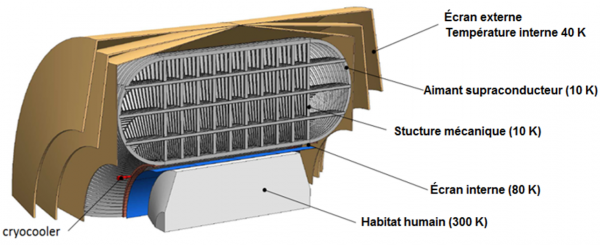For the purpose of human missions to Mars, the impact of ionizing radiation on the human body will have to be limited to minimize the risk of fatal cancer. The main sources of radioactive exposure in space are charged particles emitted by the sun, and galactic cosmic rays. While shielding strategies already exist for solar particles, designing effective shielding against cosmic radiation is more difficult. The solution adopted to protect the human habitat of a space vessel consists in producing a static magnetic field, using large toroidal superconducting magnets, to deflect the paths of charged particles. This magnetic shielding system calls for critical technologies (minimizing magnet weight and ensuring dependable operation and cooling) that must be developed and validated. The European SR2S project (Space Radiation Superconducting Shield; www.sr2s.eu) was set up to drive progress in these areas. Several configurations have been studied over a period of three years, including the large ATLAS detector on CERN’s LHC (see 3D view above), which produces the required shielding field, while creating an almost zero field in the cabin located at the center.
SACM’s main tasks were to study the shielding and cryogenic cooling of this type of magnetic system, which is 10 m long, with an inner diameter of 5 m. The laboratory has proposed an innovative shielding system using superconducting switches and an ad hoc partition of the windings making up the magnet. On this basis, in the event of quench, the magnet temperature only rises to 170 K without any damage. The cooling system combines space and cryogenic technologies (see 3D view below). Receiving only about ten watts, the magnet will be directly cooled by cryogenerators via thermal conductive links. But it is also necessary to intercept the radiated heat from the human habitat, which is maintained at a temperature of 300 K by a thermal shield maintained at an approximate temperature of 80 K. For this purpose, cooling systems that are independent of gravity were chosen in order to distribute the cryogenerator power throughout the thermal shield. The selected system is a multi-channel pulsating heat pipe, currently being tested at SACM (see the section on Pulsating Heat Pipes).
• Innovation for detection systems › Achievements in response to societal challenges superconducting magnet physics and technology
• Accelerators, Cryogenics and Magnetism Division (DACM)
• LCSE





